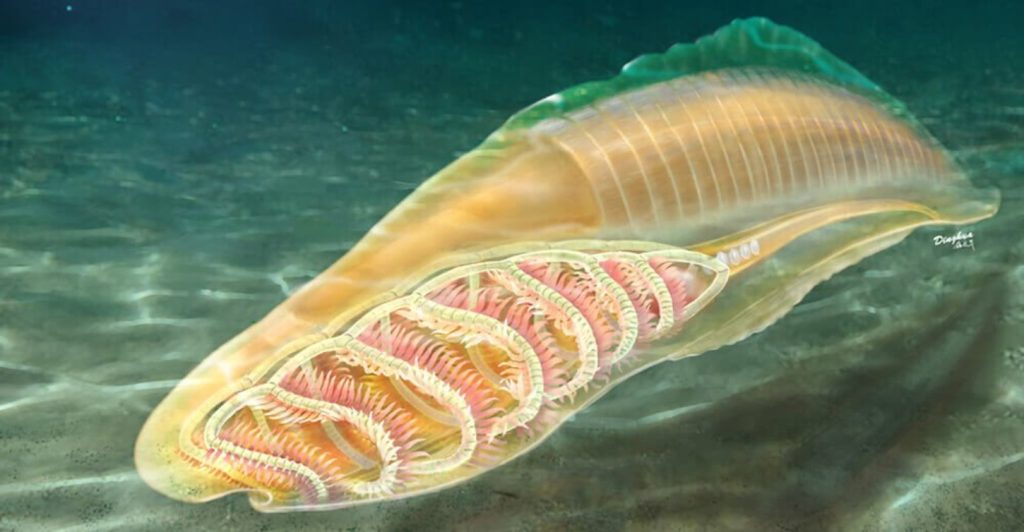For a long time, scientists have tried to trace human existence to its roots. The question, “Who is man’s earliest ancestor?” remains the elephant in the room. But a research finding seems to have the answer.

Scientists announced that they have discovered traces of an extinct bag-like creature called Saccorhytus. The creature which lived 540 million years ago is likely man’s earliest known ancestor.
Saccorhytus
The saccorhytus is a microscopic creature whose name relates to the sack-like features of its elliptical-shaped body. The most prominent feature of the animal is its large mouth, which makes the creature look like an angry minion.

Its identification followed the discovery of its microfossils in the Shaanxi province of Central China. The saccorhytus still remains arguably the most monumental finding in the quest for human origin.
An Unusual and Exciting Find
The saccorhytus was an unusual creature. On investigation, scientists discovered that it had no anus, meaning that its mouth facilitated both the intake and excretion of food.

Prof Simon Conway Morris, from the University of Cambridge, a member of the team of researchers drawn from China, Germany, and the UK, throws more light on the discovery. “To the naked eye, the fossils we studied look like tiny black grains, but under the microscope the level of detail was jaw-dropping.”
Saccorhytus to Fish to Human
Scientists believe that the saccorhytus is the most elementary example of a category of animals called “Deuterostomes.” Deuterostomes are the common ancestors of a wide range of animals, including the group of animals with backbones.

Saccorhytus is believed to have lived in hiding between grains of sand in the sea bed. More interestingly, it evolved into fish and then into humans after hundreds of millions of years.
What Scientists Say About Deuterostomes
The saccorhytus discovery is a monumental leap in the search for man’s beginnings. Experts believe we are probably just a few million years closer to the very source of man’s existence.

“We think that as an early deuterostome this may represent the primitive beginnings of a very diverse range of species, including ourselves,” said Professor Morris. “All deuterostomes had a common ancestor, and we think that is what we are looking at here,” the Professor continued.
Many Deuterostome Discoveries Have Been Made
Before scientists found the saccorhytus, they had discovered lots of fossils of various deuterostome groups. “Our team has notched up some important discoveries in the past, including the earliest fish and a remarkable variety of other early deuterostomes,” said Degan Shu from Northwest University.

These were the groups of deuterostomes that existed between 510 to 520 million years ago.
But Deuterostome Discoveries Couldn’t Reveal Much
However, their discovery failed to translate into significant scientific progress. The groups, which included animals such as starfish and sea urchins, were too distinct from one another to reveal what their common ancestor looked like. The saccorhytus has shined a bright light on this grey area.

“Saccorhytus now gives us remarkable insights into the very first stages of the evolution of a group that led to the fish, and ultimately, to us,” Shu continued.
More Features of the Saccorhytus
A closer look at this mysterious and prestigious creature revealed more startling features. Scientists noticed that it had a covering of thin and flexible skin and muscles.

This feature guided scientists to suspect that the animal moved by wriggling which was achieved by contracting its muscles. Yet another curious part of the saccorhytus was the numerous conical structures on its body.
The Saccorhytus Seemed to Have a Feature Similar to Gills
These conical structures on the saccorhytus’s body sparked much interest from inquisitive scientists. After extensive study, it was believed that this body part was responsible for letting out water the animal had swallowed, just like the gills.

This body part could have metamorphosed into what we know as gills, which play a crucial role in the survival of fishes.
The Saccorhytus is an Ecdysozoan
Researchers have been able to place the saccorhytus into the ecdysozoan, a group which which includes arthropods (animals without backbones such as spiders, scorpions, shrimps, and crabs) and nematodes (such as roundworms, hookworm, and lungworms).

To arrive at this classification, researchers carefully “considered lots of alternative groups that Saccorhytus might be related to, including the corals, anemones and jellyfish which also have a mouth but no anus,” said Professor Philip Donoghue of the University of Bristol.
How Did Scientists Come Up With the Complete Structure of the Animal?
Even though all that was discovered were fossils of some of its body parts, these remains proved very useful. Some of the fossils are so perfectly preserved that they look almost alive,” said Yunhuan Liu, professor in Palaeobiology at Chang’an University, China.

Scientists were then able to come up with a 3D digital model by referencing hundreds of X-ray images of the fossils that were taken at slightly different angles.
The Possibilities of Finding Fossils Older Than the Saccorhytus are Slim
While researchers remain hopeful of finding fossils of ancestors that preceded the saccorhytus, many have admitted that this would be a miracle. That’s because earlier ancestors could be much tinier.

“If indeed the first of these animals, including Saccorhytus were very, very tiny, they could only preserve in very, very exceptional circumstances – they basically slip through the fossilization net,” Professor Morris admitted. But in the world of science, anything could be possible.
